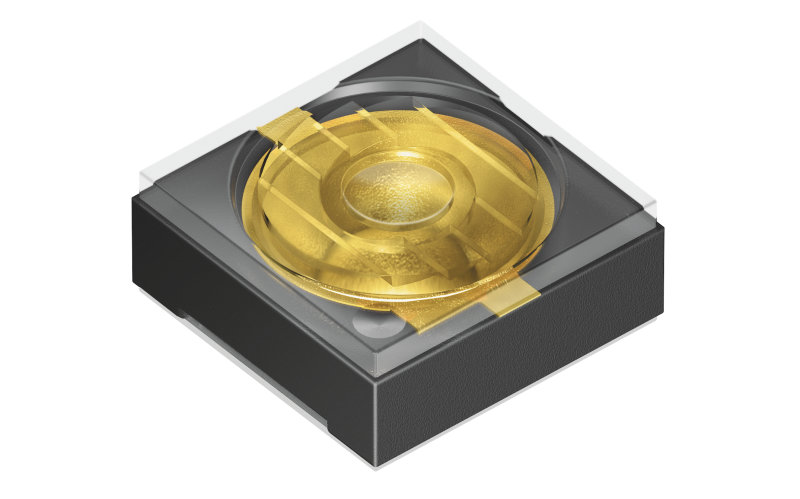Designing iris scanners just got easier

Osram Opto Semiconductors presents further infrared LEDs for biometric identification
Iris recognition systems can be made less complex and with lower profiles thanks to the SFH 4786S infrared LED (IRED) from Osram Opto Semiconductors. At 1.6 millimeters (mm) this new IRED is around one third shallower than its predecessor. Its direction of emission is slightly angled so there is no further need for the usual mechanical aids to ensure correct geometrical alignment.
Recognizing different iris patterns from one person to the next is one of the most reliable biometric identification methods. This technology has recently been adopted in smartphones and tablets to protect them against unauthorized access. In 2014 Osram Opto Semiconductors launched the Oslux SFH 4780S, the first IRED which enabled compact and reliable iris scanners to be integrated in mobile devices. Whereas the 2.4 mm high SFH 4780S is optimized for maximum light extraction, the height of the SFH 4786S has been reduced to 1.6 mm to cover demand for extremely low-profile emitters in designs where very little height is available.
A completely new feature is the 8° tilt in the emission direction of the SFH 4786S. The slightly sideways emission characteristic is beneficial for the field of view of the camera mounted a little distance away. The performance of the overall system is significantly better than one with an emitter emitting vertically upwards. Up to now, mechanical means have therefore been used in iris scanners to tilt the IRED slightly. “This additional expense is no longer needed with the SFH 4786S”, said Bianka Schnabel, Marketing Manager at Osram Opto Semiconductors. “For our customers this greatly reduces the level of complexity in designing iris scanners.” The application also benefits from the somewhat broader emission angle of +-13° which allows a larger area to be illuminated at the customary working distance for iris scanners in mobile devices. The radiant intensity of the SFH 4786S is typically 1,750 milliwatts per steradiant (mW/sr) at a current of 1 amp (A).
Like the SFH 4780S, the SFH 4786S emits light with a wavelength of 810 nanometers (nm). In this spectral range it is possible to achieve high-contrast images for all iris colors. The chips are of nanostack design in order to provide two emission centers per emitter and therefore maximum optical output. Both IREDs are based on the highly efficient Oslux package which focuses the light very tightly with its reflector and an appropriate internal lens. It is therefore capable not only of providing very high radiant intensities but also of being extremely easy to process thanks to its flat surface. Also worth noting is the low thermal resistance of the package of 25 kelvin per watt (K/W). Compared to the SFH 4780S, the only difference designers have to take into consideration is the smaller component height of the SFH 4786S; the footprint remains the same.
The SFH 4786S is already available on request for first customer projects. Volume start-up is planned for the end of January 2016.
Technical data Oslux SFH 4786S:
| Dimensions | 3.5 mm x 3.5 mm x 1.6 mm |
| Wavelength | 810 nm |
| Radiant intensity | typ. 1,750 mW/sr bei 1 A |
| Tilt angle for emission | 8° |
| Emission angle | ± 13° |
| Thermal resistance | 25 K/W |
ABOUT OSRAM
OSRAM, based in Munich, is a globally leading lighting manufacturer with a history dating back more than 100 years. The portfolio ranges from high-tech applications based on semiconductor technology, such as infrared or laser lighting, to smart and connected lighting solutions in buildings and cities. OSRAM had around 33,000 employees worldwide at the end of fiscal 2015 (September 30) and generated revenue of almost €5.6 billion in that fiscal year. The company is listed on the stock exchanges in Frankfurt and Munich (ISIN: DE000LED4000; WKN: LED 400; trading symbol: OSR). Additional information can be found at www.osram-group.com.